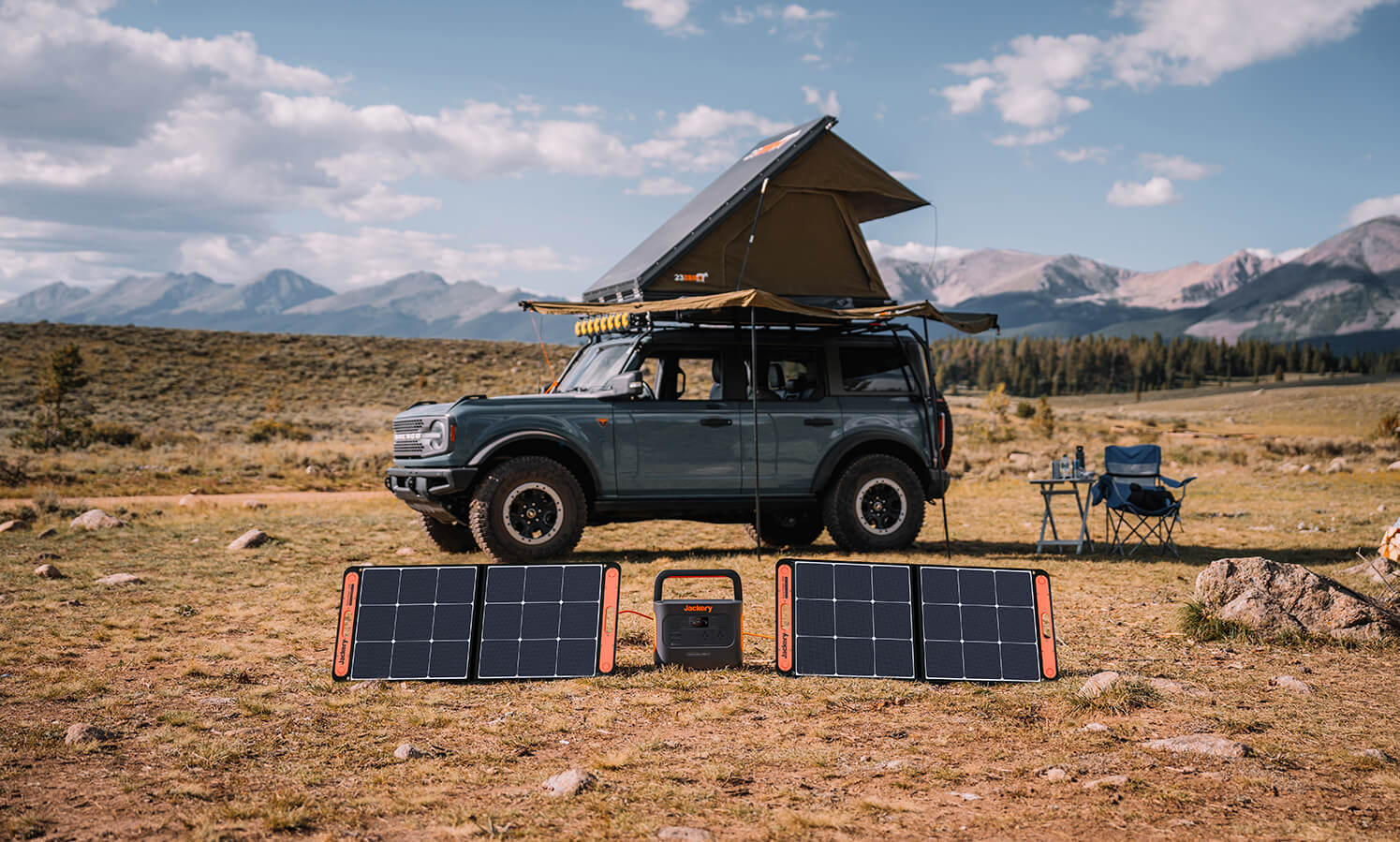|
Key Takeaways: |
|
• A power surge is a brief voltage, current, or power burst in an electrical circuit. • Power surges occur in two ways: when there is an interruption in the flow of electricity followed by a short; when an increased power delivery is interrupted when electricity is sent back into the system. • There are four main reasons to cause a power surge: electrical overload, faulty wiring, lightning strikes, and power outages. • To prevent a power surge, you should set up a surge protection system, unplug essential appliances, upgrade the wiring, fix overloaded circuits, and prepare a backup generator. • Jackery Solar Generators are suitable for power surges due to their higher capacity, lower noise, and portability. We highly recommend Solar Generator 2000 Plus and 1000 Pro as backup generators for your home. • If you've encountered a power surge, disconnect any gadgets plugged in during the surge. Then, reset the circuit breaker and reconnect your devices. |
What Is A Power Surge?
A power surge is a brief voltage, current, or power burst in an electrical circuit. This is typically a sub-cycle overvoltage that lasts less than a half-cycle of the standard voltage waveform and can be additive or subtractive, with positive or negative polarity.
This is typically an oversupply of voltage from a source such as a power supply or generator that lasts barely a few microseconds. Surges usually last 50 microseconds, and despite their brief lifetime, they can reach 6000 Volts and 3000 Amps by the time they go to powered equipment. Various events, including equipment malfunctions, lightning discharges, capacitor bank building, and load switching, cause surges. The ability of the equipment to endure transients has a significant impact on its reliability.
Your home is full of items that are prone to power surges. Anything with a microprocessor is especially vulnerable; the small digital components are so sensitive that even a 10-volt fluctuation can impair regular operation. Numerous everyday devices rely on microprocessors., including televisions, cordless phones, laptops, microwaves, and even seemingly "low-tech" significant appliances such as dishwashers, washing machines, and refrigerators.
|
Level of Power Surges |
Instructions |
|
Large Power Surges |
It may melt plastic and metal components and "frying" circuits in a second, like a lightning strike. Thankfully, power spikes like this don't happen very often. |
|
Medium Power Surges |
Although they won't burn components or blow fuses, they may induce "electronic rust," a slow but steady internal circuitry degradation that eventually fails. |
|
Small Power Surges |
Even though they may happen hundreds of times a day, you may not notice any little surges since they don't leave any visible signs. |
What Are The Types of Power Surges?
Power surges occur in two ways: When a short interruption follows an interruption in the flow of electricity and whenever there is a disruption in the increased power supply due to internal or external factors.
Internal Sources of Power Surges
Internally induced power surges occur within the electrical system. So, for example, one of the most common causes of power surges is the rapid start of a power-hungry equipment or appliance. Some equipment, such as refrigerators, freezers, and motors, consume so much electricity that simply starting them can generate a massive power surge.
Magnetic and Inductive Coupling: A magnetic field is generated when electric current flows. If this magnetic field spreads to a second wire, it will cause a voltage. This is the fundamental idea underlying transformer operation. A magnetic field in the primary creates a voltage in the secondary. In the case of adjacent or neighbouring building wiring, this voltage is undesired and may be temporary.
Static Electricity: Electrostatic discharge (ESD), often known as static, can generate electromagnetic fields over various frequencies, including low gigahertz range. The term ESD event refers to the discharge current, electromagnetic fields, and corona effects that occur before and during the discharge. ESD causes a quick transfer of charge between bodies with different electrostatic potentials. ESD created on the electrical distribution contains a significant amount of high-frequency noise.
An electrostatic discharge can cause both equipment malfunction and physical damage. Equipment malfunctions may involve data corruption and lock-ups. Physical damage can range from equipment damage to death. The complete system must be designed for direct discharge and fields.
Switching of Electrical Loads: Switching (on and off) and operating specific electrical loads, intentionally or unintentionally, can cause surges in the electrical system. Switching surges are not necessarily as apparent or disruptive as more significant externally induced surges, but they happen far more frequently. These switching spikes can cause disruption and damage to equipment over time. They are part of everyday operations.
- Switching of capacitor banks and loads
- Discharge of inductive devices (motors, etc.)
- Contactor, breaker and relay operations
- Starting and stopping appliances
- Ground faults
- Arc initiation
- Loose connections
- Power system recovery
External Sources of Power Surges
External power surges are triggered by an outside influence that hurts your electrical system. The most prevalent cause of external power surges is adverse weather, namely lightning. As you may expect, lightning includes a tremendous quantity of electrical power. If lightning strikes your house or enters your electrical system another way (such as crossing a power line), it might generate a tremendous power surge.
Lightning strikes are highly harmful to electronics, and a single poorly timed lightning hit can damage or destroy thousands of dollars in sensitive equipment. Consider how many expensive electronic gadgets you have connected to a single outlet. Many individuals have a television, gaming console, speaker system, and computer connected to the same outlet; now imagine a single power surge ruining all those electronics simultaneously.
Unsurprisingly, individuals are ready to spend so much on pricey surge protectors. The only way to protect yourself from lightning strike-induced power surges is to switch off your devices whenever a storm hits or invest in several effective surge protectors.

What Causes A Power Surge?
A power surge can result from a variety of factors. The primary causes include electrical overload, lousy wiring, lightning strikes, and power restoration after an outage or blackout. Let's go over each of these causes in more depth.
- Electrical Overload: Electrical overload occurs when too much electricity is pulled from a single circuit. This is typically caused by overusing extension cords and plugging too many gadgets into the same circuit. Power surges are prevalent during electrical overloads because the overloaded single circuit might get a significant current and subsequent voltage spike from the pulled excess power.
- Faulty Wiring: Faulty wiring can create power surges, which are more common when electrical wires are broken or exposed. Faulty wiring might be hidden behind walls, making it difficult to detect. However, there are additional indications that bad wiring exists. Signs of a defective outlet include burn marks, a burning smell, buzzing sounds, and frequent tripping of circuit breakers. If you notice any of these indicators, unplug all connected electrical devices immediately and, if feasible, turn off the power to the area. If you suspect defective wiring, contact a licenced electrician.
- Lightning Strike: Direct exposure to lightning rarely results in appliance damage. It can still cause havoc by producing a power spike. Lightning damage is usually caused by a direct strike on electrical lines, which generates a high voltage. When this occurs, the electrical system has no choice except to accept the extremely high current. This causes a massive voltage spike, resulting in a significant power surge. During intense storms, unplug any equipment without surge protection.
- Power Outage or Blackout: Large-scale power system failures primarily cause power outages, and while the lack of electricity rarely causes problems, the return to connection frequently does. It is usual to see a dramatic increase in current when power is restored after an outage. As a result, this power surge has the potential to cause damage to any plugged-in appliances and equipment that lack surge protection.
How to Prevent A Power Surge?
The first line of defence against power surges is to prevent them. While most external surges cannot be prevented, you can avoid several frequent causes of internal surges. Surges can be reduced before they reach the equipment. The most frequent way is to utilise surge protectors (SPDs). Aside from that, several approaches can be used depending on the severity of the anticipated surges and the powered equipment.

Method 1: Setup Surge Protection System
Using a surge protector is a simple and cheap way to safeguard valuable electronics in your house against power surges. They may not guard against lightning strikes, but they can protect against the damage produced by the frequent, low-voltage surges we encounter regularly.
A whole-house surge protection system is frequently a good investment for protecting your home from power surges. In contrast to individual device surge protectors, heavy-duty surge protection systems safeguard your entire home. Lightning bursts are guided into the ground and disperse safely. Installing a whole-house surge protection system will safeguard your home from external surges. Adding surge protector power strips to critical equipment protects against internal surges.
Method 2: Unplug Important Appliances
The most straightforward technique to avoid power surges is to unplug items that are not in use. Look around your house, and you'll see dozens of idle gadgets plugged in. Lightning rarely comes close enough to your electrical devices to cause harm, but the consequences are severe and dangerous.
You may safeguard your home from the effects of a storm by disconnecting essential appliances, televisions, and computers as it approaches. Power strips and whole-house surge protectors can both safeguard your electrical devices. Disconnecting is the most effective safeguard. Make sure disconnecting is at the top of your hurricane checklist.
Method 3: Upgrade Inadequate Wiring
Insufficient wiring could be the culprit if you live in an older home. Electrical systems in pre-1980s homes were not meant to support huge refrigerators, entertainment systems, and computers. Some apparent symptoms of poor wiring include frequently blown fuses, tripped circuit breakers, and lights that flicker or fade when the refrigerator or another major appliance is turned on. Be aware of these signs; they indicate something needs to be fixed, and the problem could become a fire hazard.
Method 4: Fix Overloaded Circuits
If your home is relatively new, you may be experiencing an overloaded circuit. Look for two (or more) large appliances that consume power from the same circuit, particularly in the kitchen. Another potential source of trouble is a circuit with many smaller devices, such as a family room full of computers and entertainment equipment. Request that your electrician install dedicated circuits for each large appliance and separate circuits with many gadgets in rooms.
Method 5: Prepare A Backup Generator
Using a generator during a power surge can help keep your home's power on. There are two fundamental types of generators: solar-powered generators and fuel generators. Solar generators use solar PVs to absorb sunlight and generate electricity stored in a portable power station, similar to a large battery bank. Solar generators, such as the Jackery Solar Generators, can power several appliances simultaneously.
Gas and diesel generators are economical, easy to use, and can run continuously with enough fuel. However, they are also noisy and dirty and need constant refilling and upkeep. Examining the toxic fumes and greenhouse gas emissions produced by fossil fuel generators and the long-term costs of frequent refuelling makes sense.
Domestic solar power is rapidly gaining popularity, particularly as an alternative to gasoline generators, which are noisy and dirty and require frequent refilling and maintenance. Jackery Solar Generators are perfect power sources for your house, allowing you to remain connected during power outages. The integrated solar panel generates renewable and environmentally friendly power.
Jackery Solar Generators for Power Surges
Jackery is a famous manufacturer of high-quality solar products, such as the Jackery Solar Generators. A Jackery Solar Generator is a portable solar power system that transforms sunlight into electricity before storing it in batteries for later use. Unlike traditional gas-fired generators, solar generators operate quietly, emit no pollutants, and require little maintenance.

Jackery Portable Power Stations offer multiple power output options, such as AC outlets, DC connectors, and USB ports, to charge electronics and power home appliances. The Jackery Explorer 2000 Plus, 1000 Pro, and 300 Plus portable power stations are incredibly lightweight and portable, making them perfect for emergencies. By connecting Jackery Solar Panels to Jackery Portable Power Stations, the Jackery Solar Generator maximises solar energy use.
Jackery Solar Generator 1000 Pro
The Jackery Solar Generator 1000 Pro is a sophisticated power solution designed with technology and efficiency at its core. This generator demonstrates adaptability and versatility by providing rapid AC recharge in just 1.8 hours, guaranteeing you never go without power when needed. This generator's excellent 1002Wh capacity and powerful 1000W output that can peak at 2000W easily accommodate your power-hungry gadgets and appliances.
It's built to last a decade, even with weekly use, making it a dependable long-term partner. Fast charging is now possible because of its twin 100W PD fast charging feature. If you need to swiftly charge your flashlights, smartphones, or other PD-compatible devices, the Jackery Solar Generator 1000 Pro covers you. Finally, the Jackery Solar Generator 1000 Pro emphasises flexibility. It provides three handy ways to recharge: solar energy, an AC outlet, and a vehicular output. This ensures you can keep the generator ready to operate regardless of location or circumstances.

Jackery Solar Generator 2000 Plus
Jackery's high-performance Solar Generator 2000 Plus substantially advances portable power options. Its massive capacity and high power output allow it to power standard vans for weeks, making it ideal for outdoor trips or home backup power supply. Incorporating battery cells into the Jackery Solar Generator 2000 Plus increases capacity from 2 kWh to 12 kWh, resulting in a paradigm shift in household backup power supply.
The Explorer 2000 Plus can deliver up to 3000W and has a 30% higher rated power than comparable 2 kWh models. Powered devices make up the vast majority of essential household appliances. Despite its regular use, the Solar Generator 2000 Plus can be fully charged in 6 hours (using 6* SolarSaga 100W solar panels). The power source becomes self-sufficient, charging from solar energy instead of the power grid.
The add-on battery pack can be charged with solar panels, providing additional flexibility while boosting charging efficiency and saving time. Jackery Solar Panels produce more lifetime energy due to their excellent solar conversion efficiency of up to 25%. Our solar panels produce 50% more electricity in low-light circumstances than traditional solar panels (PERC) and have a more robust spectrum response.

What Size Solar Generator Do I Need?
When deciding on the generator size to purchase, consider the amp rating of your caravan. Then, use the calculation below to calculate how much capacity you require in watts.
Amps (A) x volts (V) = watts (W)
To choose the correct solar generator size, examine your energy usage, solar panel efficiency, battery storage capacity, and your equipment's specific requirements. Selecting the appropriate size solar generator entails balancing energy requirements, installation efficiency, mobility, and cost. Depending on their energy needs, customers can choose a Jackery Solar Generator with capacities ranging from 12 kWh to 300Wh for a portable solar system. The formula for calculating the operational hours of Jackery Solar Generator-powered appliances is as follows:
Working Hours (H) = [Jackery Solar Generator Capacity (Wh)*0.85] / Appliance's Wattage (W)
The Jackery Solar Generator 2000 Pro can power a 100W ceiling fan for 18.36 hours (2160Wh x 0.85/100). This calculation helps determine the hours when appliances can operate.
What To Do After A Power Surge?
If you've encountered a power surge, follow these procedures to ensure your house and devices are safe and ready to use. Disconnect any gadgets that were plugged in during the surge. Then, reset the circuit breaker and reconnect your devices. Make sure your appliances, devices, and electrical outlets are not damaged.
Take note of outlets that are not working, have burn marks, or emit strong odours. If you observe any appliance damage, try resetting the device and the circuit breaker to determine if that's the cause. If you discover any burnt or odorous outlets, call an electrician.
Check that your HVAC systems are working correctly. If you notice any concerns, contact a local HVAC specialist. If you continue to experience troubles following a power surge, such as tripped breakers or flickering lights, contact a licenced electrician in your region. You may have faulty wiring, which raises the risk of fire and personal injury.
Power Surge FAQs
The following are the frequently asked questions about power surges in Australia:
1. How do power surges happen?
Power surges can occur in three ways: an interruption in the flow of electricity followed by a short, increased delivery of power interrupted by electricity flowing back into the system or a sudden increase in voltage caused by internal or external forces. Power surges can range from a single volt beyond the threshold of 169 volts to hundreds of excess volts, such as when lightning strikes power lines or transformers.
2. What are the differences between a power surge and a power outage?
Power surges occur when your electrical system's voltage unexpectedly increases. To elaborate, a sudden shift in the electrical draw to one piece of equipment in your more extensive system will suck power away from the rest of your electrical appliances, causing the power to cut off abruptly. This "surge" in power is not necessarily a problem, but it might harm your equipment depending on the source and timing. For example, if lightning strikes nearby power lines, it may send excessive electricity to your wiring, potentially damaging any equipment you use.
In contrast, a power outage is just a loss of electricity caused by a sudden disruption in your power supply. Power outages, sometimes known as "blackouts," are a problem for households and business owners because they cut off power and can cause data loss in computers and other devices. Surges, unlike outages, can also cause hardware damage to your gadgets. A power surge can cause an outage, damaging hardware and data.
3. Can power surge damage appliances?
Power surges can cause damage to gadgets that are plugged in. They can also harm electrical outlets. Damage from a power surge could not be covered by homeowners insurance. Consider getting an extended warranty for appliances affected by power surges.
Final Thoughts
Now that you've learned everything you need about power surges, you must protect yourself from them. Remember to disconnect any necessary electronics or sophisticated appliances during severe storms and attempt to give your larger appliances their circuits or plugs from which to draw electricity. Investing in a Jackery Solar Generator is also recommended as a backup power supply during a power surge.


























































